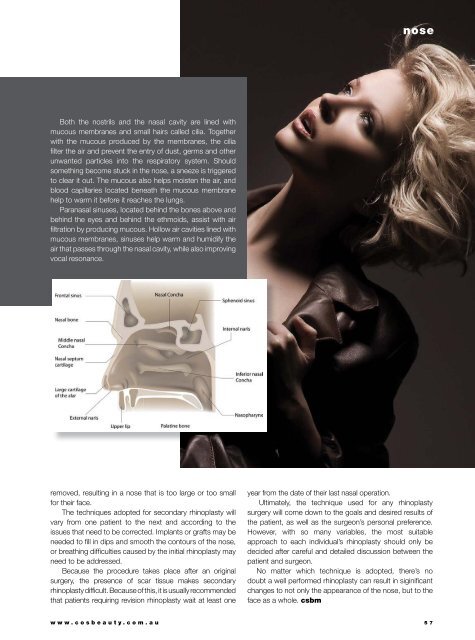Cosmetic Surgery and Beauty Magazine #68
Create successful ePaper yourself
Turn your PDF publications into a flip-book with our unique Google optimized e-Paper software.
nose<br />
Both the nostrils <strong>and</strong> the nasal cavity are lined with<br />
mucous membranes <strong>and</strong> small hairs called cilia. Together<br />
with the mucous produced by the membranes, the cilia<br />
fi lter the air <strong>and</strong> prevent the entry of dust, germs <strong>and</strong> other<br />
unwanted particles into the respiratory system. Should<br />
something become stuck in the nose, a sneeze is triggered<br />
to clear it out. The mucous also helps moisten the air, <strong>and</strong><br />
blood capillaries located beneath the mucous membrane<br />
help to warm it before it reaches the lungs.<br />
Paranasal sinuses, located behind the bones above <strong>and</strong><br />
behind the eyes <strong>and</strong> behind the ethmoids, assist with air<br />
fi ltration by producing mucous. Hollow air cavities lined with<br />
mucous membranes, sinuses help warm <strong>and</strong> humidify the<br />
air that passes through the nasal cavity, while also improving<br />
vocal resonance.<br />
removed, resulting in a nose that is too large or too small<br />
for their face.<br />
The techniques adopted for secondary rhinoplasty will<br />
vary from one patient to the next <strong>and</strong> according to the<br />
issues that need to be corrected. Implants or grafts may be<br />
needed to fi ll in dips <strong>and</strong> smooth the contours of the nose,<br />
or breathing diffi culties caused by the initial rhinoplasty may<br />
need to be addressed.<br />
Because the procedure takes place after an original<br />
surgery, the presence of scar tissue makes secondary<br />
rhinoplasty diffi cult. Because of this, it is usually recommended<br />
that patients requiring revision rhinoplasty wait at least one<br />
year from the date of their last nasal operation.<br />
Ultimately, the technique used for any rhinoplasty<br />
surgery will come down to the goals <strong>and</strong> desired results of<br />
the patient, as well as the surgeon’s personal preference.<br />
However, with so many variables, the most suitable<br />
approach to each individual’s rhinoplasty should only be<br />
decided after careful <strong>and</strong> detailed discussion between the<br />
patient <strong>and</strong> surgeon.<br />
No matter which technique is adopted, there’s no<br />
doubt a well performed rhinoplasty can result in siginifi cant<br />
changes to not only the appearance of the nose, but to the<br />
face as a whole. csbm<br />
www.cosbeauty.com.au 57


















